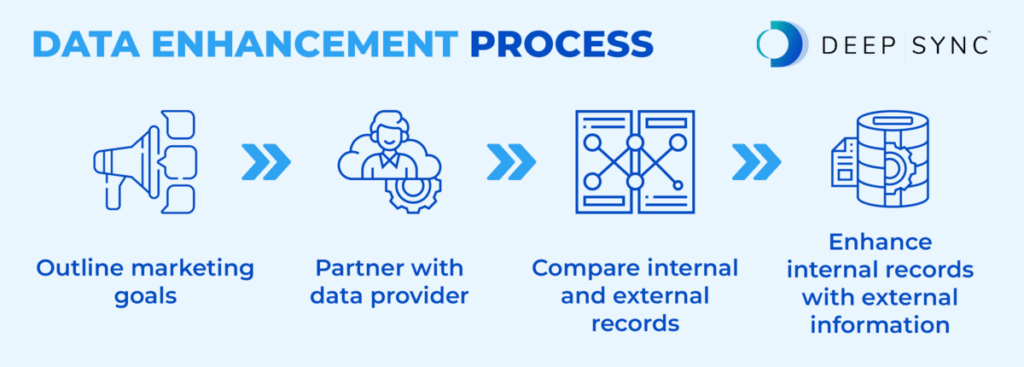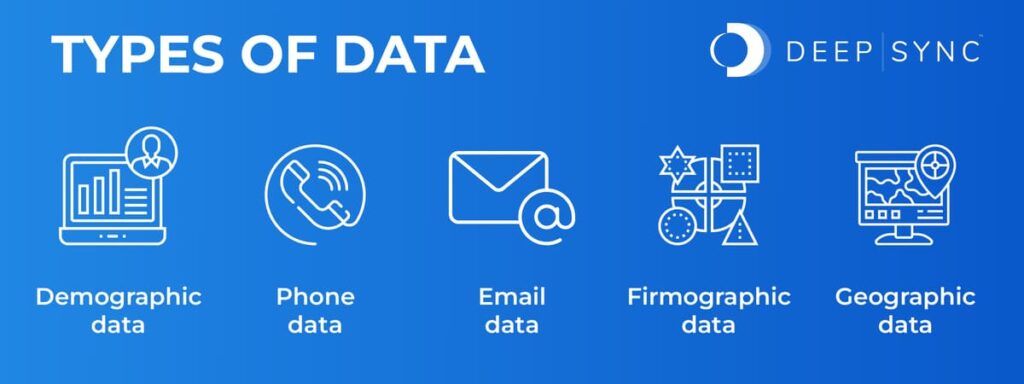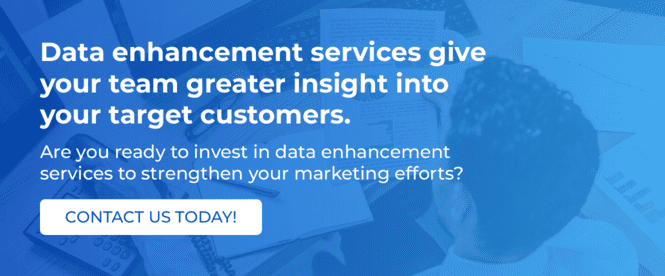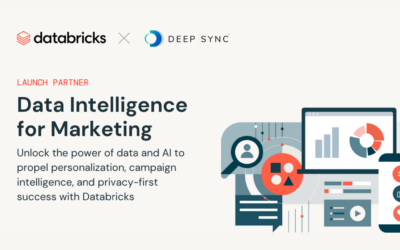Data append, data enrichment, data enhancement—modern marketers have heard all of these terms and more when it comes to the process of improving their data assets for more effective outreach.
But, what is data enhancement? And, how can it impact your, or your client’s, marketing strategy?
At Deep Sync, we work with brands, agencies, and data resellers to enhance their internal data assets. As veterans in this space, we’ve created this guide to provide you with a deeper understanding of how data enhancement can elevate your team’s efforts.
This guide will take a deep dive into data enhancement through the following points:
- What Is Data Enhancement?
- Why Should You Invest in Data Enhancement?
- Data Enhancement Tips to Elevate Your Database
Then, we’ll wrap up with a quick discussion of how you can begin the data enhancement process today. Let’s dive in!

What Is Data Enhancement?
Data enhancement generally refers to the process of improving your, or your client’s, first-party data with context pulled from additional, external sources.
This process is also referred to as data append, which generally describes adding external data to your records to expand them. A wide variety of data can be appended depending on your marketing needs, whether contact, demographic, firmographic, or geographic information.
The data enhancement process follows this general format:

- Your team outlines your marketing goals, specifically noting what data assets will be most helpful to achieve them.
- You partner with a data provider (such as Deep Sync) to enhance your database.
- Your internal records are compared side-by-side with external datasets, aligning your records with the third-party data.
- Information is pulled from these third-party datasets to supplement your existing records and create a more comprehensive picture of your audience.
When you enhance your data, you expand your datasets with new context that allows you to improve your marketing efforts. Whether you’re expanding into a new target market or seeking new context about your existing audience, data enhancement is the solution.
Types of Data You Can Append Through Data Enhancement
As mentioned in the previous section, there are several different types of data you can append to your records, depending on your marketing goals. Let’s dive deeper into each of these data types.

Demographic Appends
Demographic data can give you some basic insight into who your customers are. This information can help you tailor your marketing efforts to different customers’ wants, needs, interests, and pain points.
The demographic data you may append to your database through data enhancement includes:
- Age
- Income
- Marital status
- Level of education
- Presence of children in home
- Lifestyle attributes
- Buying behaviors
Let’s say you’re running a back-to-school marketing campaign for a clothing brand. Your ideal customers would be high school students or parents of elementary and middle school students. To target these customers specifically, you could append age data and information about the presence of children in the home to your existing customer records so you can focus your outreach on those most likely to convert.
Phone Appends
Did you know that the average American spends 4 hours and 37 minutes on their phone each day? With phone appends, you can reach your customers on their mobile devices—where they already spend much of their time—through texts or phone calls.
When appending phone data, there are two different processes you may follow:
- Standard Phone Append: This process allows you to add phone numbers to incomplete customer records using the customer information you already have.
- Reverse Phone Append: If you already have customer phone numbers, you can use that data to obtain other pieces of information, such as customer names and email addresses.
For example, you may be working with a political organization looking to raise money for an upcoming text-to-give campaign. When conducting a database audit, the organization finds that they only have phone numbers for 20% of their constituents. To power a successful fundraising campaign, they can append phone numbers to their database by uploading their records to their data provider’s system, which will match these records against an external database to supply this missing data.
Email Appends
Email is a tried-and-true marketing channel, with the average open rate for an email marketing campaign at 36.5%. However, it’s extremely easy for email addresses to become outdated—whether your audience members have started a new job, graduated, switched email providers, or simply stopped using a certain account.
Just like phone appends, there are two different ways to conduct an email append:
- Standard Email Append: You can work with a data provider to append missing email addresses to incomplete customer records or update existing ones.
- Reverse Email Append: Alternatively, you can use email address data to learn more about your customers and acquire information like customer names and phone numbers.
When it comes to email marketing and appending, it’s important to respect your audience’s wishes regarding direct marketing solicitations. By working with a reputable data provider, you can identify customers who have registered with the ANA’s DMAChoice™ Program and avoid sending them unwanted messages.
Firmographic Appends
Firmographic data relates to organizations and businesses rather than individuals. Agencies and brands conducting business-to-business (B2B) marketing campaigns may benefit from appending this type of data, which includes information like:
- Industry
- NAICS code
- Internal structure
- Annual revenue
- Size
- Market segment
- Location
- Phone numbers
- Website address
- Email addresses
- Key contacts
Let’s say you run a project management software company and want to start working with larger businesses. By appending firmographic data, you can learn more about your prospects, including their business size, how to contact them, and who the best people to get in contact with are.
Geographic Appends
Lastly, you can append geographic data to your database to enable geotargeting and greater personalization. This type of append involves adding latitude and longitude coordinates to your customer data to power hyper-targeted marketing based on your customers’ location.
For example, let’s say you’re hosting an event to promote a new product. With geographic appends, you can identify customers within a certain radius of the venue and only market to those nearby to reserve resources for people most likely to attend.
Data Enhancement vs. Data Enrichment: What’s the difference?
In the realm of data marketing, there are a few different buzzwords that are frequently used to describe the same service: data enhancement, data enrichment, and even data append.
These terms all essentially refer to the same thing— the process of improving or enhancing your data with information pulled from external sources. So, whether the data provider refers to it as “data enhancement” or “data enrichment,” you’re investing in new data to add to and enhance your first-party (internal) data regardless.

With that in mind, we want to make sure that data enhancement/enrichment isn’t mistaken for data hygiene, which is another process that improves your brand’s internal records. Data hygiene refers to how accurate your database is, and it involves processes such as auditing your records, discovering discrepancies, and resolving those errors.
Data enhancement/enrichment and data hygiene cross paths when this “clean-up” reveals missing information— such as customer records that are missing contact data like email addresses, phone numbers, and home addresses. In that case, data enhancement would be used to add the missing information to the database, resulting in more hygienic records.
However, the two processes diverge when it comes to appending other types of data—such as demographic information—to your database to otherwise enhance your marketing efforts. In this instance, the enhancement is to expand or otherwise help you better target your audience rather than to fill in gaps in your database.
Why Should You Invest in Data Enhancement?
If you Google “data append and purchasing data”, you might be dissuaded from the process with op-eds about the power of organic data capture and list building. With all of this in mind, why should you invest in data enhancement rather than relying only on your existing internal records?
There are a variety of benefits that come with investing in data enhancement, including:
- Time savings. Capturing data about your prospects organically, whether through a loyalty program, survey on your website, or something else, can take quite some time. Additionally, it provides little information about prospects that haven’t engaged with your brand yet. Data enhancement can give you that information almost immediately.
- Costs savings. Because appended data is verified for both accuracy and responsiveness, you’re less likely to be sending communications to email addresses, phone numbers, and home addresses that won’t yield a response. This saves valuable marketing dollars that can then be directed toward other efforts.
- Maximized internal records. Data enrichment doesn’t replace your current records—it enhances them. If you have internal records that aren’t currently serving your strategy— for example, those with missing contact information— you can supplement those records and finally be able to connect with those prospects.
- Growth potential. If you’re looking to expand into a new market, data enhancement can provide you with demographic, geographic, and contact information to reach prospective customers within that new segment. Rather than slowly building up your contacts in that area, you can hit the ground running with insider information.
- Increased understanding of your audience. If you’re struggling to connect with your target audience, you may simply be failing to align with what truly motivates them to invest. With data enhancement, you can append new data assets to your existing customer base to understand what factors most influence success for your team.
- Improved customer experience. Improve the customer experience by sending personalized communications to your audience. Whether communicating via their preferred channel or sending opportunities they’re likely to be interested in (for example, local opportunities targeted to customers within a 5-mile radius), you’ll create marketing communications that are relevant and valuable.
Data enhancement gives your team the resources needed to discover consumers within your target audience and market to them effectively. However, it’s not as simple as investing in new data assets and calling it a day— without a strong strategy, you’ll end up with discordant records and little direction.
Let’s cover a few tips to set your data enhancement up for success.
Data Enhancement Tips to Elevate Your Database
Begin with an audit of your database.
Data enhancement, regardless of what your goals are or the information you’re seeking, always results in adding new information to your database. If that database and the first-party information contained within it isn’t well-organized and maintained, the data you append will only make the problem worse (and, the data itself will be challenging to access and use in your strategy).
Before conducting any data enhancement efforts, run a full audit of your records. An audit examines your database and highlights discrepancies, such as unclean data or missing information. This audit will:
- Give your team a realistic view of where your data assets stand right now and what discrepancies exist within your first-party data.
- Allow you to see which areas of your database are most in need of improvement.
Using the information revealed through this audit, you’ll want to fix any immediate errors in your database before appending any new information to it. This could include tasks such as:
- Standardizing information like home addresses, email addresses, phone numbers, titles, and more.
- Suppressing unnecessary information that’s not valuable for your team, such as the names and addresses of minors and individuals currently in correctional facilities.
- Removing or merging duplicate records into one cohesive file.
Alleviating these errors before appending new data to your records will prevent major headaches down the line. But, it’s also important to remember that cleaning up your records isn’t a one-and-done effort, and you’ll need to have ongoing procedures to maintain them.
If all of the above makes your head spin, keep in mind that data providers, such as Deep Sync, can provide these types of services for you.
Create ongoing data hygiene procedures.
We’ve briefly touched on the concept of data hygiene, but essentially, data hygiene refers to the cleanliness (i.e. lack of errors) of your database. Even if you conduct a comprehensive clean-up after your database audit, your newly appended data and first-party records can quickly become muddled as the data is added to your database and put to use.
All it takes is a single keystroke for an email address, phone number, or mailing address to be changed and communications to those contacts to become non-deliverable. With that in mind, it’s not surprising that dirty data can cost U.S. businesses around 3.1 trillion a year.
You’ll want to create ongoing data hygiene procedures to give your team clear instructions for maintaining your enriched data over time. This includes guidance around:
- The standardization of data entry. Create rules for how contact information, identifying information (such as titles), and more should be standardized in your database. When staff members know how to abbreviate street names, job titles, and more, they’re less likely to enter data incorrectly from the start.
- How to handle errors. Define how different errors should be handled once they’re discovered, whether a duplicate, incomplete, or incorrect record. Should the team member elevate the issue or resolve it independently? Is there a system for noting where these changes have been made?
- Preventing data build-up. Note how staff members can prevent unhelpful information from entering your system going forward. For example, are you currently collecting information in a “Contact Us” form that’s nonessential and not being used? Consider adjusting that form to only collect useful information.
Outlining data maintenance procedures now will prevent a mass clean-up down the line, so it’s worthwhile to create these rules, document them, and make sure your entire team understands them going forward.
Append data with your marketing goals in mind.
Now, let’s discuss tips for the actual data enhancement process. When it comes down to it, there is a ton of information that you can access about your audience— age, birth date, marital status, travel habits, homeownership, loans, credit score, gender, and even health status. This is just the tip of the iceberg.
The wealth of information that you can access with relative ease through data append is interesting, but not all of it will be useful for your data marketing strategy. For example, if you’re seeking firmographic data to market a business-to-business product such as a cleaning service, demographic and lifestyle data about each and every employee at the firms you’re researching isn’t going to be helpful. Instead, it’s going to clog your database and give you more information to parse through when creating your campaigns.
Prior to appending data, take a close look at your marketing goals. Rather than sorting through the masses of data that you can append, consider the information that’s needed to help reach your goals and only seek to append those data assets.
So, let’s say you’re running a digital marketing campaign for a university that’s looking to increase alumni donations using email marketing. Building off of that goal, the following data may help you in the effort:
- Alumni email addresses
- Employment status
- Marital status
- Homeowner status
- Net worth
- Modeled credit data
- Philanthropic involvement
This information would give you insight into your prospective donors’ financial capacity and affinity to give, as well as the best way to reach them. Then, you’d work with a data provider to append this information to your database. By crafting your append around your goals rather than securing data and deciding how it can help, you prevent a build-up of unnecessary information in your database (and, potentially save costs when it comes to the append itself).
Prioritize the validation of any appended data.
Just as you want to prepare your database to have new data added to it, it’s important that the data you’re appending is in tip-top shape. Any new assets that you’re adding to your first-party records should be accurate, updated, and in the case of contact information, validated for high response rates.
The best way to ensure any information appended to your database is validated for accuracy and responsiveness is to work with a trustworthy marketing analytics company.
Deep Sync not only uses leading databases when conducting data append but also validates that information. For example, in the case of email validation, each email address is analyzed independently and undergoes a multi-step process that determines its potential for deliverability. This prevents you from sending communications to deactivated inboxes, those with known SPAM traps, and more.
Validation efforts such as the example above prevent you from investing in information that won’t actually lead to results for your team. Instead, you’ll invest only in information that has a high likelihood of return.
Work with a partner that specializes in data enhancement.
Last but not least, we recommend working with a provider that specializes in data enhancement. There are many data providers on the market, many of which are automated services that give your team access to data assets and little else.
Instead, we recommend working with a full-service partner that can do all of the following:
- Give your team access to a variety of data assets.
- Validate any data assets prior to appending them to your database.
- Provide data hygiene services to save your team time and resources.
- Lend data marketing expertise to help guide data usage in your campaigns.
Incorporating a large influx of data into your marketing strategy can cause a headache if there’s not a strong plan behind how that data will be used. A dedicated data marketing partner can help you avoid these pitfalls and provide the framework you need for future success.
Learn More About Deep Sync’s Data Enhancement Services
Deep Sync provides data enhancement services for brands, agencies, and data resellers. We can provide data hygiene services to prep your database for the append, then provide your team with access to the leading consumer datasets to elevate your data assets.
Our services include:
- Marketing list-building, to help you create impactful consumer audiences and target them effectively through email, direct mail, or digital marketing.
- Data enhancement solutions, including batch append and real-time append of demographic, phone, email, firmographic, and geographic data.
- Data hygiene services to prepare your database for enhancement.
- On-demand data that empowers direct mail providers to provide their customers with mailing list data.
- Custom data solutions to meet your unique business needs.
To learn more, contact the Deep Sync team today. To explore data-driven marketing topics further, check out the following additional resources:
- Database Marketing Services: The Key to a Higher ROI. In this guide, explore database marketing services and case studies showing how these services can elevate your strategy.
- Data Hygiene: How to Make Your Data Accurate and Actionable. It’s crucial that your database is clean before you append any information to it. Explore this guide to data hygiene to bring your database to tip-top shape.
- Data-Driven Marketing: A Comprehensive Guide to Success. Are you new to the idea of using data in your marketing strategy? Explore this guide to learn the essentials of data-driven marketing.













0 Comments